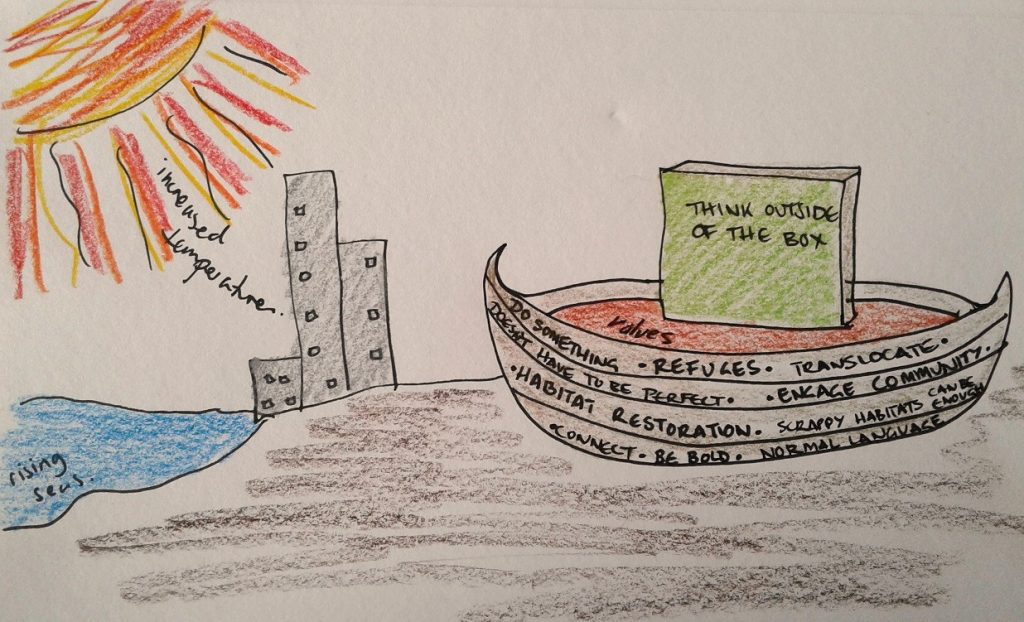In the right boat – Biodiversity Across the Borders Conference
This conference included naturalists, land-managers, educators, and researchers; all people who care about the environment and are doing their best. The 8th Biodiversity Across the Borders Conference at Federation University, Ballarat took us into the world of climate change and what our future landscapes might be like.
This was uncomfortable. The first three speakers prefaced their talks with “depression alert”. But by the end of the conference I’d come up with a picture of a possible future.
Professor Lesley Hughes (Pro Vice-Chancellor, Macquarie University), gave the keynote address, “Restoration and management of ecosystems in a changing climate: no time left for business as usual”. Prof. Hughes is on numerous committees and groups. Some of his data included:
- 2018 was the 42nd consecutive year of above average temperatures
- There is 30% more acid in the oceans
- The Bureau of Meteorology has had to invent a new colour category for high temperatures
There was more, but I don’t want that depression to kick in, because Lesley Hughes moved on quickly to our “to do” list which included shifting the goal-posts of what conservation work is needed:
- Reducing other stresses on systems so they are as resilient as possible to climate effects
- Reconnecting habitats
- Climate refuges (identify and protect)
- Creating new habitats
- Move species because they won’t be able to move fast enough in our fragmented landscapes
- Be bolder and take calculated risks
- Take action
- Advocate for the environment
- Do it now!
Professor Brendan Wintle (The University of Melbourne) spoke about, “Six steps to halting Australia’s extinction crisis, and how science can help”. More depressing statistics, but here are some of the action tips!
- Spend more money on conservation. We spend $500 million a year on pet grooming in Australia
- Incentives for farming that includes regenerative or biodiverse approaches
- Engage with Traditional Owners on land management
- Political will and regulations (these require lobbying to achieve)
- Adaptation strategies – how do we help species to move, disperse and cope?
- Hope! Tell stories about success.
There was a change of perspective from Professor Kathryn Williams (The University of Melbourne), speaking about “Experiencing nature: psychological perspectives on conservation”. This was my favourite talk, so much so that I went to visit Kath a few weeks later for an in-depth conversation. I’ve also expanded my reading list a lot! Kath talked about new (old) ways of seeing place and interacting with nature.
Plant blindness is a thing! People don’t know the names of plants, but more than that, they just see them as “greenness”, rather than recognising trees, shrubs, grasses etc. What people cannot see, they do not notice and do not value. First experiences of nature are important in helping people to “see”, and from there to connect! Without a sense of connection, it is extremely unlikely that people will act to care for nature.
One model for this is that experiences lead to connection, and that connection will give outcomes:
There were so many great speakers demonstrating the value of paying attention to what we see, and how that connection leads to greater understanding, connection and action:
- Sandra Penman had studied the response of bat communities to fire in the Otway Ranges. Bats have preferences for forest types. Bats with short wings like to be in cluttered areas, or stay close to clutter. Whereas bats with longer wings spend time above the canopy or in open spaces … but this is happening well above people height and bats have a very 3D view of the world.
- Dr. Diana Kuchinke looked at birds and how they respond to fire in the heathy dry forests of central Victoria. Her call to arms was three pronged:
- Monitor the common birds –they will give us a lot more information more quickly about what is happening
- Loss of hollows is critical for numerous species. We need to do something now
- Look for kookaburras and put in records. They are long-lived, use hollows, and people are concerned about them.
- Mandy Watson from DELWP spoke about how the whale “paparazzi” have transformed Southern Right Whale research with increased quality and quantity of identification photographs. They have also helped with monitoring entangled whales, and planning and documenting disentanglement operations. Citizen scientists can now contribute their photos via SWIFFT (State Wide Integrated Flora and Fauna Team)
By the end of the day I’d connected with old friends, listened to some really interesting talks, and met a few new people. I also had a strong sense that the work we are doing (and thinking about doing) at NGT is in the right boat.


